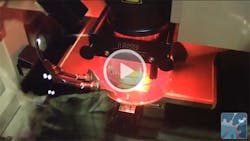UV Laser Delamination Raises the Rapid-Prototyping Bar
Watch the Engineering TV video above to see the ProtoLaser U3 in action.
To accelerate 2D-surface prototyping, LPKF equipped its ProtoLaser U3 with an ultraviolet (UV) laser to selectively delaminate and cut substrates. The system, which requires only an electrical connection, dust extraction, and compressed air, can be used on a variety of materials, including ceramic, LTCC (green tape), FR4, Rogers, protective sheets, and metal foils or flexible and flex-rigid materials.
Capable of structuring laminated substrates, the system produces ultra-fine conductors with a 70-μm line width and 30-μm distance, while simultaneously gently removing large metal surfaces. As a result, it will find homes in high-precision geometry, high-repeat accuracy, and layout data-protection applications. According to LPKF,
First, it produces the contours of the conductor path structure; then it removes the remaining copper surfaces using reduced power. For this process, a specialized hood is required which, along with the dust extraction, also has a compressed air feature. Both hoods and the LPKF CAM software are included in delivery.
Touted as the first hybrid milling/laser system, its speed—capable of completing a prototype in three minutes—will fit well in R&D as well as small-scale production. The ProtoLaser U3 was unveiled for the first time at this year’s International Microwave Symposium (IMS). Watch the video above for a look at the system, courtesy of Technical Editor, Jean-Jacques DeLisle. Also be sure to check out other videos from IMS 2014 over at Engineering TV.
About the Author
Iliza Sokol
Associate Digital Editor
Iliza joined the Penton Media group in 2013 after graduating from the Fashion Institute of Technology with a BS in Advertising and Marketing Communications. Prior to joining the staff, she worked at NYLON Magazine and a ghostwriting firm based in New York.
Jean-Jacques DeLisle
Jean-Jacques graduated from the Rochester Institute of Technology, where he completed his Master of Science in Electrical Engineering. In his studies, Jean-Jacques focused on Control Systems Design, Mixed-Signal IC Design, and RF Design. His research focus was in smart-sensor platform design for RF connector applications for the telecommunications industry. During his research, Jean-Jacques developed a passion for the field of RF/microwaves and expanded his knowledge by doing R&D for the telecommunications industry.

